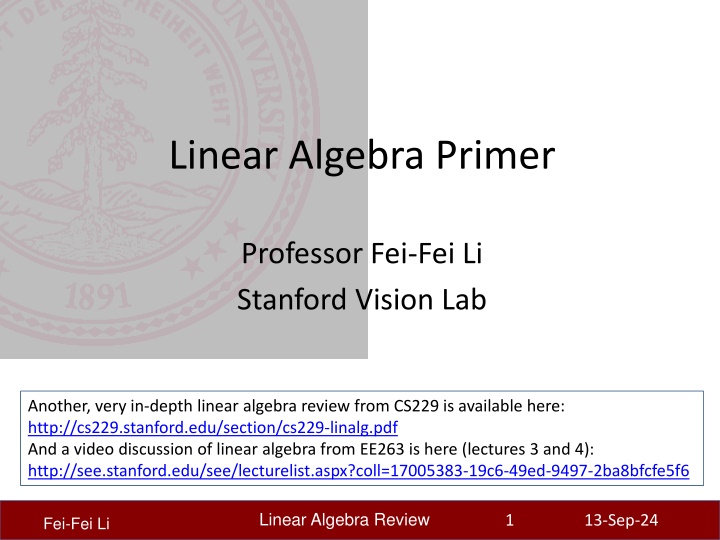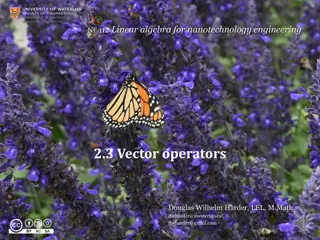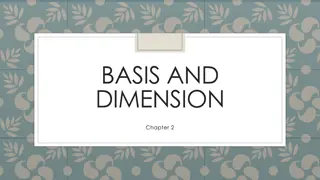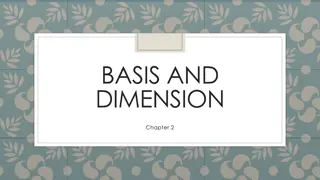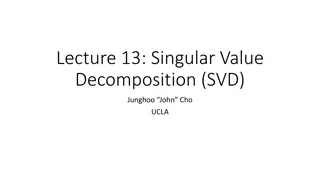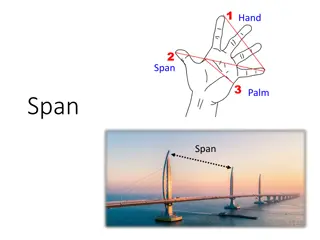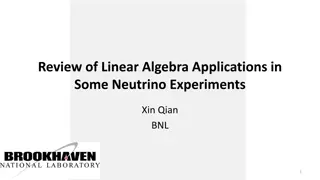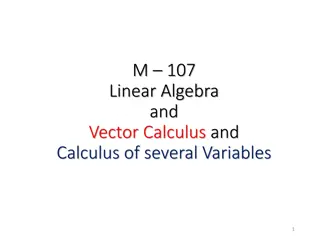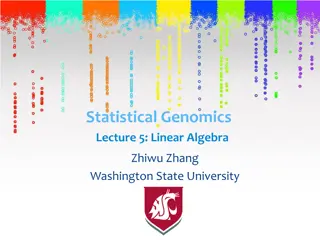Linear Algebra Overview and Resources at Stanford
Explore a comprehensive overview of linear algebra concepts, operations, and applications through resources from Stanford University's CS229 and EE263, featuring in-depth reviews, matrices, vectors, transformations, SVD, PCA, and more.
Download Presentation

Please find below an Image/Link to download the presentation.
The content on the website is provided AS IS for your information and personal use only. It may not be sold, licensed, or shared on other websites without obtaining consent from the author.If you encounter any issues during the download, it is possible that the publisher has removed the file from their server.
You are allowed to download the files provided on this website for personal or commercial use, subject to the condition that they are used lawfully. All files are the property of their respective owners.
The content on the website is provided AS IS for your information and personal use only. It may not be sold, licensed, or shared on other websites without obtaining consent from the author.
E N D
Presentation Transcript
Linear Algebra Primer Professor Fei-Fei Li Stanford Vision Lab Another, very in-depth linear algebra review from CS229 is available here: http://cs229.stanford.edu/section/cs229-linalg.pdf And a video discussion of linear algebra from EE263 is here (lectures 3 and 4): http://see.stanford.edu/see/lecturelist.aspx?coll=17005383-19c6-49ed-9497-2ba8bfcfe5f6 Linear Algebra Review 1 13-Sep-24 Fei-Fei Li
Outline Vectors and matrices Basic Matrix Operations Special Matrices Transformation Matrices Homogeneous coordinates Translation Matrix inverse Matrix rank Singular Value Decomposition (SVD) Use for image compression Use for Principal Component Analysis (PCA) Computer algorithm Linear Algebra Review 2 13-Sep-24 Fei-Fei Li
Outline Vectors and matrices are just collections of ordered numbers that represent something: movements in space, scaling factors, pixel brightnesses, etc. We ll define some common uses and standard operations on them. Vectors and matrices Basic Matrix Operations Special Matrices Transformation Matrices Homogeneous coordinates Translation Matrix inverse Matrix rank Singular Value Decomposition (SVD) Use for image compression Use for Principal Component Analysis (PCA) Computer algorithm Linear Algebra Review 3 13-Sep-24 Fei-Fei Li
Vector A column vector where A row vector where denotes the transpose operation Linear Algebra Review 4 13-Sep-24 Fei-Fei Li
Vector We ll default to column vectors in this class You ll want to keep track of the orientation of your vectors when programming in MATLAB You can transpose a vector V in MATLAB by writing V . (But in class materials, we will always use VT to indicate transpose, and we will use V to mean V prime ) Linear Algebra Review 5 13-Sep-24 Fei-Fei Li
Vectors have two main uses Data (pixels, gradients at an image keypoint, etc) can also be treated as a vector Such vectors don t have a geometric interpretation, but calculations like distance can still have value Vectors can represent an offset in 2D or 3D space Points are just vectors from the origin Linear Algebra Review 6 13-Sep-24 Fei-Fei Li
Matrix A matrix is an array of numbers with size ? by ? , i.e. m rows and n columns. If , we say that is square. Linear Algebra Review 7 13-Sep-24 Fei-Fei Li
Images = MATLAB represents an image as a matrix of pixel brightnesses Note that matrix coordinates are NOT Cartesian coordinates. The upper left corner is [y,x] = (1,1) Linear Algebra Review 8 13-Sep-24 Fei-Fei Li
Color Images Grayscale images have one number per pixel, and are stored as an m n matrix. Color images have 3 numbers per pixel red, green, and blue brightnesses Stored as an m n 3 matrix = Linear Algebra Review 9 13-Sep-24 Fei-Fei Li
Basic Matrix Operations We will discuss: Addition Scaling Dot product Multiplication Transpose Inverse / pseudoinverse Determinant / trace Linear Algebra Review 10 13-Sep-24 Fei-Fei Li
Matrix Operations Addition Can only add a matrix with matching dimensions, or a scalar. Scaling Linear Algebra Review 11 13-Sep-24 Fei-Fei Li
Matrix Operations Inner product (dot product) of vectors Multiply corresponding entries of two vectors and add up the result x y is also |x||y|Cos( the angle between x and y ) Linear Algebra Review 12 13-Sep-24 Fei-Fei Li
Matrix Operations Inner product (dot product) of vectors If B is a unit vector, then A B gives the length of A which lies in the direction of B Linear Algebra Review 13 13-Sep-24 Fei-Fei Li
Matrix Operations Multiplication The product AB is: Each entry in the result is (that row of A) dot product with (that column of B) Many uses, which will be covered later Linear Algebra Review 14 13-Sep-24 Fei-Fei Li
Matrix Operations Multiplication example: Each entry of the matrix product is made by taking the dot product of the corresponding row in the left matrix, with the corresponding column in the right one. Linear Algebra Review 15 13-Sep-24 Fei-Fei Li
Matrix Operations Powers By convention, we can refer to the matrix product AA as A2, and AAA as A3, etc. Obviously only square matrices can be multiplied that way Linear Algebra Review 16 13-Sep-24 Fei-Fei Li
Matrix Operations Transpose flip matrix, so row 1 becomes column 1 A useful identity: Linear Algebra Review 17 13-Sep-24 Fei-Fei Li
Matrix Operations Determinant returns a scalar Represents area (or volume) of the parallelogram described by the vectors in the rows of the matrix For , Properties: Linear Algebra Review 18 13-Sep-24 Fei-Fei Li
Matrix Operations Trace Invariant to a lot of transformations, so it s used sometimes in proofs. (Rarely in this class though.) Properties: Linear Algebra Review 19 13-Sep-24 Fei-Fei Li
Special Matrices Identity matrix I Square matrix, 1 s along diagonal, 0 s elsewhere I [another matrix] = [that matrix] Diagonal matrix Square matrix with numbers along diagonal, 0 s elsewhere A diagonal [another matrix] scales the rows of that matrix Linear Algebra Review 20 13-Sep-24 Fei-Fei Li
Special Matrices Symmetric matrix Skew-symmetric matrix Linear Algebra Review 21 13-Sep-24 Fei-Fei Li
Outline Vectors and matrices Basic Matrix Operations Special Matrices Transformation Matrices Homogeneous coordinates Translation Matrix inverse Matrix rank Singular Value Decomposition (SVD) Use for image compression Use for Principal Component Analysis (PCA) Computer algorithm Matrix multiplication can be used to transform vectors. A matrix used in this way is called a transformation matrix. Linear Algebra Review 22 13-Sep-24 Fei-Fei Li
Transformation Matrices can be used to transform vectors in useful ways, through multiplication: x = Ax Simplest is scaling: (Verify to yourself that the matrix multiplication works out this way) Linear Algebra Review 23 13-Sep-24 Fei-Fei Li
Rotation How can you convert a vector represented in frame 0 to a new, rotated coordinate frame 1 ? Remember what a vector is: [component in direction of the frame s x axis, component in direction of y axis] Linear Algebra Review 24 13-Sep-24 Fei-Fei Li
Rotation So to rotate it we must produce this vector: [component in direction of new x axis, component in direction of new y axis] We can do this easily with dot products! New x coordinate is [original vector] dot [the new x axis] New y coordinate is [original vector] dot [the new y axis] Linear Algebra Review 25 13-Sep-24 Fei-Fei Li
Rotation Insight: this is what happens in a matrix*vector multiplication Result x coordinate is [original vector] dot [matrix row 1] So matrix multiplication can rotate a vector p: Linear Algebra Review 26 13-Sep-24 Fei-Fei Li
Rotation Suppose we express a point in a coordinate system which is rotated left If we use the result in the same coordinate system, we have rotated the point right Thus, rotation matrices can be used to rotate vectors. We ll usually think of them in that sense-- as operators to rotate vectors Linear Algebra Review 27 13-Sep-24 Fei-Fei Li
2D Rotation Matrix Formula Counter-clockwise rotation by an angle = = + ' x ' y cos cos x y sin sin y x P y P y cos ' cos sin x x x x = ' sin y y P'= R P Linear Algebra Review Fei-Fei Li 28 13-Sep-24
Transformation Matrices Multiple transformation matrices can be used to transform a point: p =R2 R1 S p The effect of this is to apply their transformations one after the other, from right to left. In the example above, the result is (R2 (R1 (S p))) The result is exactly the same if we multiply the matrices first, to form a single transformation matrix: p =(R2 R1 S) p Linear Algebra Review 29 13-Sep-24 Fei-Fei Li
Homogeneous system In general, a matrix multiplication lets us linearly combine components of a vector This is sufficient for scale, rotate, skew transformations. But notice, we can t add a constant! Linear Algebra Review 30 13-Sep-24 Fei-Fei Li
Homogeneous system The (somewhat hacky) solution? Stick a 1 at the end of every vector: Now we can rotate, scale, and skew like before, AND translate (note how the multiplication works out, above) This is called homogeneous coordinates Linear Algebra Review 31 13-Sep-24 Fei-Fei Li
Homogeneous system In homogeneous coordinates, the multiplication works out so the rightmost column of the matrix is a vector that gets added. Generally, a homogeneous transformation matrix will have a bottom row of [0 0 1], so that the result has a 1 at the bottom too. Linear Algebra Review 32 13-Sep-24 Fei-Fei Li
Homogeneous system One more thing we might want: to divide the result by something For example, we may want to divide by a coordinate, to make things scale down as they get farther away in a camera image Matrix multiplication can t actually divide So, by convention, in homogeneous coordinates, we ll divide the result by its last coordinate after doing a matrix multiplication Linear Algebra Review 33 13-Sep-24 Fei-Fei Li
2D Translation P P t Linear Algebra Review Fei-Fei Li 34 13-Sep-24
2D Translation using Homogeneous Coordinates = P ( t , ) ( , ) 1 , t x y x y P t = t ( , ) ( , ) 1 , y t t ty P x y x t P y + 1 0 x t t x x tx x x + 1 = P ' 0 1 y t t y y y 0 0 1 1 I 0 t 1 = = P T P Linear Algebra Review Fei-Fei Li 35 13-Sep-24
Scaling P P Linear Algebra Review Fei-Fei Li 36 13-Sep-24
Scaling Equation P = = sy y P P ) y , x ( ' s ( s , x x ) y y P y = P ( , ) ( , ) 1 , s x y x y = P ' ( , ) ( , ) 1 , y s x s y x s x y x y sx x 0 x 0 s 0 s x s x x x S 0 ' = P = = ' 0 s y y P S P y y 0 1 1 0 0 1 1 S Linear Algebra Review Fei-Fei Li 37 13-Sep-24
Scaling & Translating P P P =S P P =T P P =T P =T (S P)= T S P = A P Linear Algebra Review Fei-Fei Li 38 13-Sep-24
Scaling & Translating 1 0 0 s 0 t s x x x = = = P T S P ' ' 0 1 0 0 t y y y x 0 0 1 0 0 1 1 + 0 s s t x s t x x x x x x S t = = + = 0 t y s y t y y y y y y 0 1 0 0 1 1 1 1 1 A Linear Algebra Review Fei-Fei Li 39 13-Sep-24
Translating & Scaling != Scaling & Translating + 1 0 t s 0 0 x s 0 t x s x t x x x x x x = = = = + 1 ' ' ' P T S P 0 1 t 0 s 0 y 0 s t y s y t y y y y y y 0 0 1 0 0 1 1 0 0 1 1 s 0 0 1 0 t x x x = = = ' ' ' P S T P 0 s 0 0 1 t y y y x 0 0 1 0 0 1 1 + s 0 s t x s s t x x x x x x = = + 1 0 s s t y s y s t y y y y y y 0 0 1 1 Linear Algebra Review Fei-Fei Li 40 13-Sep-24
Rotation P P Linear Algebra Review Fei-Fei Li 41 13-Sep-24
Rotation Equations Counter-clockwise rotation by an angle = = + ' x ' y cos cos x y sin sin y x P y P y cos ' cos sin x x x x = ' sin y y P'= R P Linear Algebra Review Fei-Fei Li 42 13-Sep-24
Rotation Matrix Properties Transpose of a rotation matrix produces a rotation in the opposite direction = = T T R R R R I = R det( ) 1 The rows of a rotation matrix are always mutually perpendicular (a.k.a. orthogonal) unit vectors (and so are its columns) Linear Algebra Review 43 13-Sep-24 Fei-Fei Li
Properties cos ' cos sin x x = ' sin y y A 2D rotation matrix is 2x2 Note: R belongs to the category of normal matrices and satisfies many interesting properties: = = T T R R R R I = R det( ) 1 Linear Algebra Review Fei-Fei Li 44 13-Sep-24
Rotation+ Scaling +Translation P = (T R S) P cos 1 0 t cos in s 0 s 0 0 x x x = = = P T S P ' R 0 1 t sin 0 0 s 0 y y y 0 0 1 0 0 1 0 0 1 1 cos cos in s t s 0 0 x x x = = sin t 0 s 0 y y y This is the form of the general-purpose transformation matrix 0 0 1 0 0 1 1 x x 0 R t S R S t = = y y 0 1 0 1 0 1 1 1 Linear Algebra Review Fei-Fei Li 45 13-Sep-24
Outline Vectors and matrices Basic Matrix Operations Special Matrices Transformation Matrices Homogeneous coordinates Translation Matrix inverse Matrix rank Singular Value Decomposition (SVD) Use for image compression Use for Principal Component Analysis (PCA) Computer algorithm The inverse of a transformation matrix reverses its effect Linear Algebra Review 46 13-Sep-24 Fei-Fei Li
Inverse Given a matrix A, its inverse A-1is a matrix such that AA-1 = A-1A = I E.g. Inverse does not always exist. If A-1 exists, A is invertible or non-singular. Otherwise, it s singular. Useful identities, for matrices that are invertible: Linear Algebra Review 47 13-Sep-24 Fei-Fei Li
Matrix Operations Pseudoinverse Say you have the matrix equation AX=B, where A and B are known, and you want to solve for X You could use MATLAB to calculate the inverse and premultiply by it: A-1AX=A-1B X=A-1B MATLAB command would be inv(A)*B But calculating the inverse for large matrices often brings problems with computer floating-point resolution (because it involves working with very small and very large numbers together). Or, your matrix might not even have an inverse. Linear Algebra Review 48 13-Sep-24 Fei-Fei Li
Matrix Operations Pseudoinverse Fortunately, there are workarounds to solve AX=B in these situations. And MATLAB can do them! Instead of taking an inverse, directly ask MATLAB to solve for X in AX=B, by typing A\B MATLAB will try several appropriate numerical methods (including the pseudoinverse if the inverse doesn t exist) MATLAB will return the value of X which solves the equation If there is no exact solution, it will return the closest one If there are many solutions, it will return the smallest one Linear Algebra Review 49 13-Sep-24 Fei-Fei Li
Matrix Operations MATLAB example: >> x = A\B x = 1.0000 -0.5000 Linear Algebra Review 50 13-Sep-24 Fei-Fei Li
